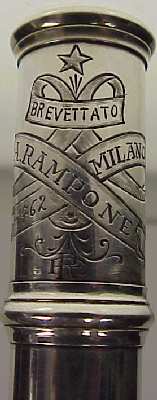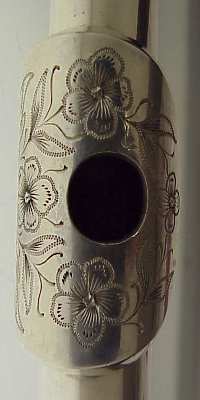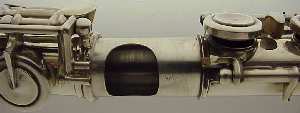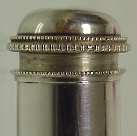 
A. Rampone & B. Cazzani & Co.
Serial # 1462; Milan; 1930(?) Model 570(?);
silver plated(?)
body & mechanism, soldered; sl 643mm; 555g; .012"h .0135"b
The Rampone family flourished as instrument
makers
in Milano from the 1850's and, in 1879, became the first Italian maker
of Boehm flutes. In 1912 Egidio Rampone went into partnership with
Battista
Cazzani, soon marrying his daughter. Following Cazzani's death in
1920, the firms merged into "Ditte riunite A. Rampone e. B. Cazzani e .
C." (New Langwill
Index by William Waterhouse, publ. Tony
Bingham, London)
Previous
owner was a sax player who found the flute in an antique store and had
it repaired to double on. Too few gigs called for flute, so he
sold
it. With a little adjustment and repair of a leaking solder join, the
instrument
plays quite nicely, albeit it is a bit of a challenge to bring it up to
modern concert pitch. The very circular embouchure makes for a
sweet
upper range but requires technique to bring out the bottom end. |








 When
unscrewed to adjust the cork, the crown turns out to be a bit of a
surprise
as well. Instead of the ornamentation being entirely on the
crown,
it begins with the end of the headjoint body, which has been formed
into
a beaded ring to exactly match the corresponding beading on the crown.
Hey, why not?
When
unscrewed to adjust the cork, the crown turns out to be a bit of a
surprise
as well. Instead of the ornamentation being entirely on the
crown,
it begins with the end of the headjoint body, which has been formed
into
a beaded ring to exactly match the corresponding beading on the crown.
Hey, why not? 